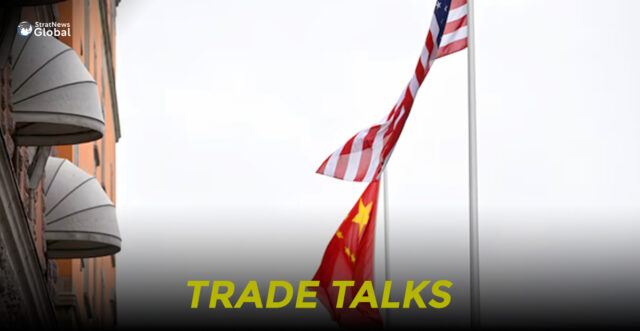U.S. and Chinese officials entered a second day of talks in Stockholm on Tuesday aimed at resolving longstanding economic disputes and de-escalating the intensifying trade tensions between the world’s two largest economies.
The meetings may not yield immediate large breakthroughs, but the two sides could agree to another 90-day extension of a tariff truce struck in mid-May. It may also pave the way for a potential meeting between U.S. President Donald Trump and Chinese President Xi Jinping later in the year, though Trump on Tuesday denied going out of his way to seek one.
The delegations met for more than five hours on Monday at Rosenbad, the Swedish prime minister’s office in central Stockholm. Neither side made statements after the first day of talks.
U.S. Treasury Secretary Scott Bessent was seen arriving at Rosenbad on Tuesday morning after a separate meeting with Swedish Prime Minister Ulf Kristersson. China’s Vice Premier He Lifeng also arrived at the venue.
August 12 Deadline
China is facing an August 12 deadline to reach a durable tariff agreement with Trump’s administration, after reaching preliminary deals in May and June to end weeks of escalating tit-for-tat tariffs and a cut-off of rare earth minerals.
Without an agreement, global supply chains could face renewed turmoil from U.S. duties snapping back to triple-digit levels that would amount to a bilateral trade embargo.
The Stockholm talks follow Trump’s biggest trade deal yet with the European Union on Sunday for a 15% tariff on most EU goods exports to the United States, and a deal with Japan.
That agreement has brought a measure of relief to the EU but also frustration and anger, with France denouncing the deal as a “submission” and Germany, Europe’s largest economy, also warning of “significant” damage.
China can exercise a degree of leverage with its grip on the global market for rare earths and magnets, used in everything from military hardware to car windshield wiper motors, analysts say.
Unlike the EU, it also does not rely on the United States for security ties and can let trade talks play out for several more months, Cyrus de la Rubia, chief economist at Hamburg Commercial Bank, told Reuters.
“China is well aware of its strong negotiating position, as could clearly be seen in the temporary escalation observed in April,” he said.
“But over Europe always hangs the Damocles sword of the U.S. withdrawing its security guarantee, and that is why the EU did not escalate the situation like China did.”
Trump On Xi Meeting
The Financial Times reported on Monday that the United States had paused curbs on tech exports to China to avoid disrupting trade talks with Beijing and support Trump’s efforts to secure a meeting with Xi this year.
Trump pushed back against suggestions he was seeking a meeting with Xi. “This is not correct, I am not SEEKING anything! I may go to China, but it would only be at the invitation of President Xi, which has been extended. Otherwise, no interest!” he wrote on Truth Social on Tuesday.
Previous U.S.-China trade talks in Geneva and London in May and June focused on bringing U.S. and Chinese retaliatory tariffs down from triple-digit levels and restoring the flow of rare earth minerals halted by China and Nvidia’s H20 AI chips, and other goods halted by the United States.
Among broader economic issues, Washington complains that China’s state-led, export-driven model is flooding world markets with cheap goods, while Beijing says U.S. national security export controls on tech goods seek to stunt Chinese growth.
Bessent has already flagged a deadline extension and has said he wants China to rebalance its economy away from exports to more domestic consumption — a decades-long goal for U.S. policymakers.
(With inputs from Reuters)





